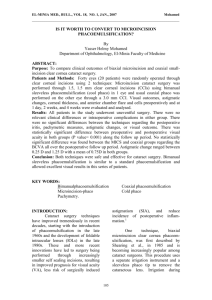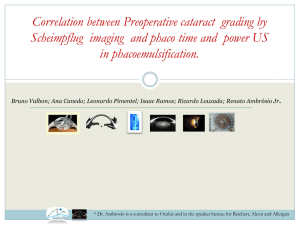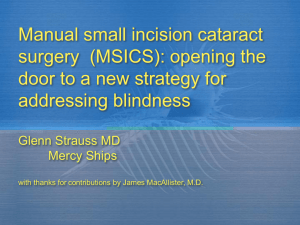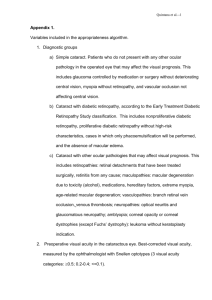Bimanual microincision phacoemulsification has multiple
advertisement
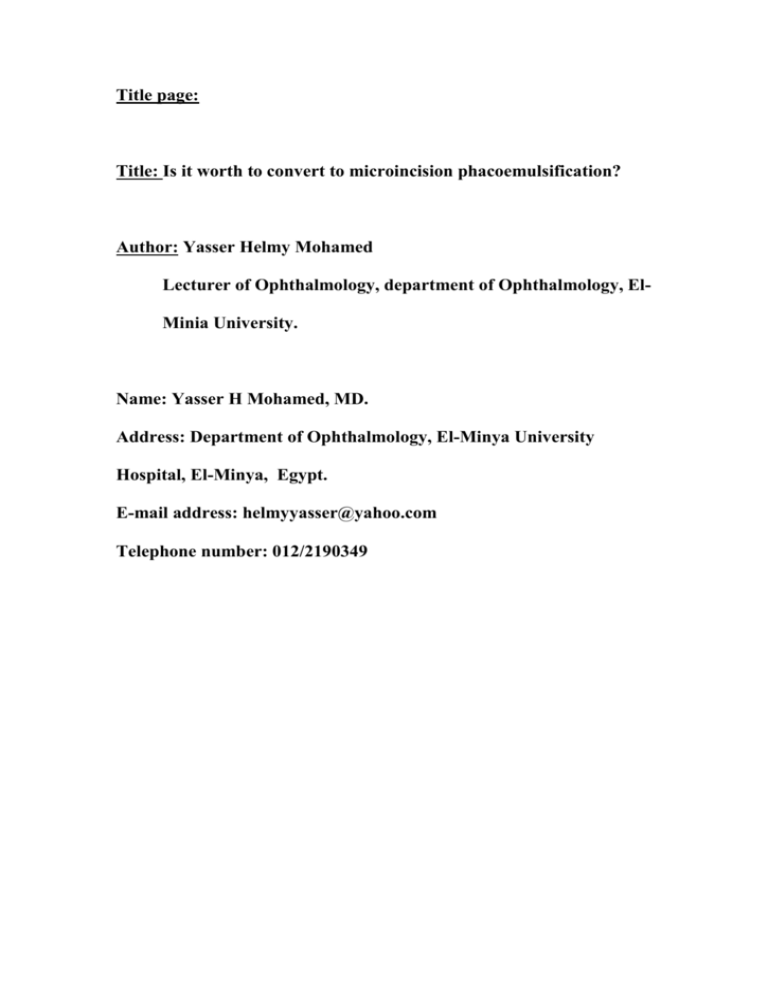
Title page: Title: Is it worth to convert to microincision phacoemulsification? Author: Yasser Helmy Mohamed Lecturer of Ophthalmology, department of Ophthalmology, ElMinia University. Name: Yasser H Mohamed, MD. Address: Department of Ophthalmology, El-Minya University Hospital, El-Minya, Egypt. E-mail address: helmyyasser@yahoo.com Telephone number: 012/2190349 Abstract: Purpose : To compare clinical outcomes of biaxial microincision and coaxial smallincision clear cornea cataract surgery. Patients and Methods: Forty eyes (20 patients) were randomly operated through clear corneal incisions using 2 techniques: Microincision cataract surgery was performed through 1.5, 1.5 mm clear corneal incisions (CCIs) using bimanual sleeveless phacoemulsification (cool phaco) in 1 eye and usual coaxial phaco was performed on the other eye through a 3.0 mm CCI. Visual outcomes, astigmatic changes, corneal thickness, and anterior chamber flare and cells preoperatively and at 1 day, 2 weeks, and 4 weeks were evaluated and analysed. Results: All patients in the study underwent uneventful surgery. There were no relevant clinical differences or intraoperative complications in either group. There were no significant differences between the techniques regarding the postoperative iritis, pachymetric measures, astigmatic changes, or visual outcome. There was statistically significant difference between preoperative and postoperative visual acuity in both groups (P value= 0.001) along the follow up period. No statistically significant difference was found between the MICS and coaxial groups regarding the BCVA all over the postoperative follow up period. Astigmatic change ranged between 0.25 D and 1.25 D with a mean of 0.75D in both groups. Conclusion: Both techniques were safe and effective for cataract surgery. Bimanual sleeveless phacoemulsification is similar to a standard phacoemulsification and allowed excellent visual results in this series of patients. INTRODUCTION: Cataract surgery techniques have improved tremendously in recent decades, starting with the introduction of phacoemulsification in the late 1960s and the development of foldable intraocular lenses (IOLs) in the late 1980s. These and more recent innovations have led to surgery being performed through increasingly smaller self sealing incisions, resulting in improved prognosis for visual acuity (VA), less risk of surgically induced astigmatism (SIA), and reduce incidence of postoperative inflammation.(1) One technique, biaxial microincision clear cornea phacoemulsification, was first described by Shearing et al in 1985 and is becoming increasingly popular among cataract surgeons. This procedure uses a separate irrigation instrument and a sleeveless phaco tip to remove the cataractous lens. Irrigation during phaco is provided through an irrigating chopper instead of the traditional phaco hand-piece. As a result, one instrument provides irrigation to the anterior chamber while the other instrument emulsifies and then aspirates the nucleus. Because irrigation is no longer provided through the phaco sleeve, a bare needle can be used to emulsify nuclear fragments.(2) This technique allows a corneal incision smaller than 1.5 mm but requires pulsed phaco energy, which prevents the development of high temperatures in the cornea and therefore reduces the incidence of corneal burns. Because the biaxial technique involves an incision smaller than that of coaxial technique, one might expect improved outcomes for biaxial microincision versus coaxial phacoemulsification.(3) Microincision cataract surgery provides advantages of wound stability, improved control and reduced chamber turbulence, resulting in early visual rehabilitation and improved results. Current techniques rely predominantly on ultrasound based phacoemulsification, which relies heavily on expensive equipment and consumables, restricting universal application of this technique particularly in resource-limited settings such as developing countries.(4) Lens extraction performed through two paracentesis-type incisions offers unique advantages that enhance surgical control and safety in cataract and refractive lens surgery. Understanding the essential features of this lens extraction technique allows an appreciation of its benefits. Reduction of incision size represents only one of many potential advantages that make this a superior approach. The crucial difference is not the size of the incision; it is the separation of inflow and outflow. In recent years, through several publications in the Journal of Cataract & Refractive Surgery, several specialists have attempted to document and quantify the effect of developments in techniques and technology of phacoemulsification.(2-7) Bimanual microincision phacoemulsification has multiple advantages that make it a preferred technique even in the absence of microincision IOLs. The growing trend in bimanualmicroincision phacoemulsification has prompted many surgeons to evaluate this new surgical technique.(8) Some believe the technique will become the standard of care in the near future. Others do not, but they all share their advice for performing it safely and effectively. AIM OF THE STUDY: To compare clinical outcomes of microincision bimanual phacoemulsification and coaxial clear cornea phacoemulsification. PATIENTS AND METHODS: Forty eyes of twenty patients with senile cataracts were randomly operated through clear corneal incisions using 2 techniques: Microincision cataract surgery (MICS) was performed through two 1.5 mm clear corneal incisions (CCIs) using bimanual sleeveless phacoemulsification (cool phaco) in one eye and usual coaxial phaco was performed on the other eye through a 3.0 mm CCI. Patients with corneal disorders, contact lens wear, previous intraocular surgery, and a history of ocular trauma or pathology were excluded from the study. Eyes with more than 3 diopters (D) of astigmatism were excluded from the study, as astigmatic incisions would be necessary. Current technique for bimanual microincision phaco may be reviewed briefly as follow: two single1.5 mm incisions are made with a disposable knife about 90 degrees apart in the clear cornea. Aqueous is exchanged for a dispersive viscoelastic and a continuous curvilinear capsulorhexis is constructed with an insulin needle. Following hydrodissection and hydrodelineation, the nucleus is impaled, chopped and mobilized using 20-gauge irrigating chopper and a 30-degree beveled straight phaco needle (Figure1). Epinucleus management permits simultaneous extraction of cortex in the great majority of cases (Figure2). The capsule and anterior chamber are filled with a cohesive viscoelastic and separate limbal incisions are performed for IOL implantation in the bag. The residual viscoelastic is irrigated In all cases, an AcrySof IOL was inserted. In the microincision group IOL was implanted through a separate 3.0 mm clear corneal incision at the 12-o' clock position. No stitches were used in any of the cases in either group. All patients received postoperative topical antibiotic and corticosteroid treatment. Patients were examined preoperatively and one day, one week, 2weeks, and 4weeks postoperatively. All patients were subjected to full ophthalmological examination both preoperatively and postoperatively at regular visits. Full ophthalmological examination includes: - Best corrected visual acuity. - Slit lamp examination. - Applanation tonometry. - Fundus examination. - Refraction of patients with great care of astigmatic error before and 4weeks after operation. - Central corneal pachymetry both preoperatively and after 4weeks postoperatively using Compuscan UPC1000 Storz. Evaluation of postoperative iritis in the two groups by careful detection of anterior chamber flare and cells was encountered during slit lamp examination. Changes in astigmatic error of all patients in the two groups were calculated and evaluated. Both intraoperative and postoperative complications in the two groups were encountered. Changes in the corneal thicknesses in all patients of both groups were calculated and evaluated. Figure (1): Showing shopping technique in bimanual phacoemulsification. Figure (2): Showing process of cortex aspiration in bimanual phacoemulsification. RESULTS: All patients (twenty patients, forty eyes) were subjected to uncomplicated surgical procedures by the same surgeon using the same machine with insertion of a foldable acrysof intraocular lens. All patients (13 females, 7 males) had senile cataract with age ranged between 55-70 years old. Postoperative examination showed no major postoperative complications. No postoperative detection of anterior chamber flare and cells in all patients of the two groups along the follow up period. There was statistically significant difference between preoperative and postoperative visual acuity in both groups (P value= 0.001) along the follow up period. No statistically significant difference was found between the MICS and coaxial groups regarding the BCVA all over the postoperative follow up period. In both groups, the BCVA was ranged between 6/60 and 6/12 with a mean of 6/18 preoperatively (P value= 0.93). The mean postoperative BCVA in both groups was 6/6 one month postoperatively (P value= 0.974). There was no statistically significant difference as regards to the postoperative change in the astigmatic error in patients of the two groups (P value= 0.63) after one month of follow up. Astigmatic change ranged between 0.25 D and 1.25 D with a mean of 0.75D in both groups. Astigmatic change between 0.25 and 0.5D was present in 10% (2 eyes) in both groups. Astigmatic change between 0.5 and 0.75 was present in 70% (14 eyes) in the coaxial group and in 75% (15 eyes) in group of MICS. Astigmatic change between 0.75 and 1.0 D was present in 15% (3 eyes) in the coaxial group and 10% (2 eyes) in the group of MICS. Astigmatic change between 1.0 and 1.25D was found in 5% (one eye) in both groups (Figure 3). In both groups, none of eyes showed astigmatic change below 0.25 D or above 1.25 D. Coaxial group 15% 5% Biaxial group 10% 70% 10% 5% 10% 1- Between0.25 and0.5D 1- Between0.25 and0.5D 2- Between0.50 and0.75D 2- Between0.50 and0.75D 3- Between0.75 and 1.0D 3- Between0.75 and 1.0D 4- Between1.0and1.25D 75% 4- Between1.0and1.25D Figure (3): Pie chart showing the degree of postoperative astigmatic change in both groups. There was no statistically significant value between the two groups as regards to the pachymetric measures after one month postoperatively(P value= 0.785). Central corneal thickness ranged between 512 and 532u preoperatively with a mean of 524u and ranged between 525 and 548u postoperatively with a mean of 538u in the coaxial group. Central corneal thickness ranged between 519 and 535u preoperatively with a mean of 526u and ranged between 530 and 551u postoperatively with a mean of 541u in the MICS group (Figure 4). Pachymetric changes in both groups 545 540 Preop-Coaxial gp Postop-Coaxial gp Preop-Biaxial gp Postop-Biaxial gp 535 530 525 520 515 1 Figure (4): Column chart showing pachymetric changes in both groups. DISCUSSION: The main evolution that cataract surgery experienced during the last decades has been parallel to the decrease in the incision size. When small incision phacoemulsification with foldable IOL implantation became the standard technique for cataract removal, most of the presumed advantages that were anticipated by pioneers such as Charles Kelman were confirmed. A shorter recovery time, less surgically induced astigmatism, and improved surgical outcomes were observed. Because the concept of reducing incision size was clearly related to better surgical outcomes, modification of the surgical technique was necessary to achieve this goal.(9) Concurrent improvement in ultrasound technology and instrumentation, including new IOL technology, accompanied the evolution of new surgical techniques, resulting in less tissue trauma, less SIA, and faster recovery.(9) All over the world surgical incisions are becoming smaller and smaller and more so in ophthalmology. The advent of bimanual phaco has made cataract surgery now possible through a sub 2 mm incision. With bimanual microincisional phacoemulsification, we are able to achieve nearly watertight conditions and an almost completely closed system. We are using smaller incisions, which are inherently safer, and we have improved followability because the fluid enters the eye from one side and leaves through the other. This flow avoids creating competing currents around the phaco tip, such as in coaxial phacoemulsification. In addition, the incoming irrigation flow can be used as a tissue manipulator, which aids in directing tissue to the phaco tip.(7) Alio et al (9) have used the term microincision cataract surgery to describe the procedure of cataract surgery with IOL implantation through such 2mm microincisions. Fluidics optimization in MICS aims for an improved control in pressure and value changes during cataract surgery, which requires a closed and stable anterior chamber. Using a closed compartment leads to a reduction of fluid circulation in the anterior chamber. Investigators are eagerly comparing ways to perform phacoemulsification to obtain the best results for patients. Bimanual microincision phaco has been receiving a great deal of attention and is being compared with conventional phaco. The growing trend in bimanual microincision phacoemulsification has prompted many surgeons to evaluate this new surgical technique. Some believe the technique will become the standard of care in the near future. Others do not, but they all share their advice for performing it safely and effectively. Bimanual microincision phacoemulsification has multiple advantages that make it a preferred technique even in the absence of microincision IOLs. The first point concerns the fluidics. During coaxial phacoemulsification, a portion of the irrigation fluid is captured by irrigation immediately after it flows out of the sleeve. Having the irrigation so close to the aspiration means that, the nuclear fragments can be pushed away. So having the irrigation in one end and the aspiration in another end means that there is an increase in followability.(2) The second consideration, having separate irrigation and aspiration, allows surgeons to use the irrigating fluid like a surgical tool.(2) There are critics who say there is no role for bimanual microincision phaco because of the need to enlarge the incision for IOL insertion. However, it is really a superior method that facilitates cataract surgery in general. Its benefits are not just about incision size, but it will have added value once microincision IOLs become available. A variety of names have been used to refer to this procedure. Based on its defining features, SIMPLE, an acronym for Separate Infusion Microincision Phacoemulsification Lens Extraction, seems to be a good alternative.(10) A recent study by Kurz et al (11) compared the outcomes of bimanual microincision phacoemulsification to coaxial microincision phacoemulsification. This prospective randomized study of 70 eyes in 70 patients evaluated the intraoperative parameters of mean phacoemulsification time, total phacoemulsification percentage, effective phacoemulsification time, total balanced salt solution (BSS) utilized, total surgical time, and final wound incision size. In addition, the postoperative parameters of corneal thickness, endothelial cell count, anterior chamber inflammation, visual acuity, and induced astigmatism by vector analysis were also evaluated. Both techniques were found to be safe and effective, with the only statistically significant differences demonstrated being less total volume of BSS utilized and a lower total surgical time in the bimanual microincision group. An earlier study by Alio et al (9)comparing bimanual to coaxial microincision phacoemulsification demonstrated lower mean total phacoemulsification percentage, lower mean effective phaco time, and less surgically induced astigmatism with the bimanual technique. There was no difference in the total amount of BSS utilized. These studies demonstrate the possible advantages of a bimanual technique over a coaxial approach in regards to both intraoperative and postoperative parameters. The lack of consistent findings between studies reveals the difficulty of drawing consistent conclusions regarding these parameters. Alio et at (9) concluded that, reduction of SIA is the most significant and important achievement of MICS in their study. A great advantage of MICS surgery is that the microincisions do not produce an increase in astigmatism, and this is considered important because cataract surgery today is considered more and more a refractive procedure. Alio et at (9) used foldable IOL inserted through 1.5mm corneal incision in the group of MICS. In this study, there was no difference in both groups as regards to SIA. This is may be due to the use of usual foldable lenses in both groups with the same size and site of corneal incision for implantation of IOL. Alio et al (9) and Kurz et al (11) concluded from their studies that, there were no statistically different values between the two groups as regards to BCVA, mean flare value, and mean pachymetric measures. These results are consistent with results in this study. Kurz et al (11) and Alio et al (9)used specular microscope to evaluate the difference between the two groups as regards to endothelial cell count loss. They concluded that there was no statistically difference between the two groups regarding the mean percentage of endothelial cell loss. In this study, secular microscopy was not available to make this comparison. In this study, pachymetric measures used as an indication of the state of the corneal endothelium and there was no statistically different values between the two groups after one month postoperatively as regards pachymetric measures.(12) Wilczynski M et al (13) compared the two groups as regards BCVA and endothelial count loss and concluded that there was no significant difference between BCVA in the two groups postoperatively. Also, Patients in the MICS group lost an average of 9.5% of corneal endothelial cells, whereas patients after standard phacoemulsification lost about 7.6% of cells. This difference was statistically insignificant. Larger studies with more participants should be carried out to study further the biochemical changes induced at the level of the cornea, possibility of corneal burns, amount of leakage, and amout of astigmatism induced by the surgery. Microincision surgery has become the Holy Grail among cataract surgeons in recent years. In fact, it’s been the impetus behind the mounting interest in microincision phacoemulsification. Yet, most ophthalmologists are far from having all the pieces of the puzzle in place to perform true micro phaco and for the majority of physicians to adopt it as their technique of choice.(5) Opponents of bimanual microincision surgery cite the need for a new learning curve, investment in additional instrumentation, and increased cataract surgical costs. Proponents cite improved “followability,” easier cortex removal, and safer surgery in difficult cases where 2 similarly sized incisions give options for approaching the lens from 2 different directions.(14) Most physicians are sitting on the sidelines, refusing to test the new technique for a number of reasons. Micro phaco is difficult to learn for the average cataract surgeon, for it requires two hands instead of one. The learning curve increases the risk for postoperative complications. There’s no U.S. Food and Drug Administrationapproved intraocular lens designed to fit through a 1.2- to 1.5-mm incision and there may not be for several years. Presently, cataract surgeons performing micro phaco have to enlarge these microincisions anyway to fit the current lenses inside the eye. If you’re not performing micro phaco on your patients currently, don’t feel guilty or pressured to do so, because true micro phaco is still not ready for prime time. Hopefully, further comparative studies of these 2 techniques will provide useful information to help surgeons determine if making a transition to a bimanual technique is worthwhile. REFERENCES: 1- Dick HB, Schwenn O, Krummenauer F, et al. Inflammation after sclerocorneal versus clear corneal tunnel phacoemulsification. Ophthalmology 2000;107:241-7. 2- Fine IH, Hoffmann RS, Packer M. Optimizing refractive lens exchange with bimanual microincision phacoemulsification. J cataract Refract Surg 2004;30:550-4. 3- Olson RJ. Clinical experience with 21-gauge manual microphacoemulsification using Sovereign WhiteStar technology in eyes with dense cataract. J Cataract Refract Surg 2004;30:168-72. 4- Donnenfeld ED, Olson RJ, Solomon R, Finger PT, Biser SA, Perry HD, Doshi S. Efficacy and wound-temperature gradient of whitestar. J Cataract Refract Surg. 2003 Jun;29(6):1097-100. 5- Fine IH, Packer M, Hoffman RS. New Phacoemulsification Technologies. J Cataract Refract Surg 2002; 28: 1054-1060. 6- Hoffman RS, Fine IH, Packer M, Brown LK. "Comparison of sonic and ultrasonic phacoemulsification utilizing the Staar Sonic Wave phacoemulsification system." J Cataract Refract Surg 2002; 28:15811584. 7- Fine IH, Packer M, Hoffman RS. “Power Modulations in New Technology: Improved Outcomes.” J Cataract Refract Surg 2004; 30:1014-1019. 8- Archinoff SA. Biaxial phacoemulsification [letter]. J Cataract Refract Surg 2005;31:646. 9- Alio J, Rodriguez-Prats JL, Galal A, Ramzy M. Outcomes of microincision cataract surgery versus coaxial phacoemulsification. Ophthalmology 2005;112:1997–2003 10- Osher RH, Barros MG, Marques DM, Marques FF, Osher JM. Early uncorrected visual acuity as a measurement of the visual outcomes of contemporary cataract surgery. J Cataract Refract Surg. 2004;30:191720. 11- Kurz S, Krummenauer F, Gabriel P, Pfeiffer N, Dick HB. Biaxial microincision versus coaxial small-incision clear cornea cataract surgery. Ophthalmology. 2006 Oct;113(10):1818-26. 12- Lundberg B, Jonsson M, Behndig A. Postoperative corneal swelling correlates strongly to corneal endothelial cell loss after phacoemulsification cataract surgery. Am J Ophthalmol. 2005 Jun;139(6):1035-41. 13- Wilczynski M, Drobniewski I, Synder A, Omulecki W. Evaluation of early corneal endothelial cell loss in bimanual microincision cataract surgery (MICS) in comparison with standard phacoemulsification. Eur J Ophthalmol. 2006 Nov-Dec;16(6):798-803. 14- Mamalis N. Is smaller better? J Cataract Refract Surg 2003;29:104950. عنوان البحث:هل من االجدر التحول الى الشق المجهرى الستحالب العدسه؟ الغرض من البحث :هو مقارنة بين النتائج االكلينيكيه الزالة المياة البيضاء بالموجات فوق الصوتيه احادية المحور و ثنائية المحور. طريقة البحث:تمت ازالة المياة البيضاء لعشرين مريضا (اربعين عينا) بالموجات فوق الصوتية مستخدمين طريقتين. الطريقة االولى هى ثنائية المحور عن طريق شق القرنية شقين كل منها 1¸ 5مم باستخدام مسبار الموجات فوق الصوتيه منزوع الغطاء (القميص) في احد العينين والعين االخرى تمت ازالة المياه البيضاء بالموجات الصوتيه احادية المحور عن طريق شق القرنية 3مم. قيمت وحللت نتائج المجموعتين من ناحية النتائج البصرية والتغيرات فى درجة االنحراف (االستجماتزم) وسمك القرنيه والتهابات القزحية. نتائج البحث :نتج البحث عن عدم وجود اية اختالفات اكلينيكيه او مضاعفات اثناء العمليات للمجموعتين. ليست هناك فروق احصائيه بين الطريقتين من حيث االلتهاب القزحى بعد العملية وسمك القرنية ودرجات االنحراف او النتائج البصرية . يترواح معدل التغير فى درجة االنحراف مابين 1¸25: 0¸25ديوبتر بمتوسط يعادل 0¸ 75درجة فى كال المجموعتين. خالصة البحث :تعتبر كال الطريقتين امان وذات فاعلية الزالة المياة البيضاء جراحيا وتكون الطريقة ثنائية المحور مساوية الحادية المحور فى هذه المجموعه البحثيه من حيث النتائج البصرية. Keywords: bimanualphacoemulsification, coaxial phacoemulsification, microincision-phaco, cold phaco, pachymetry.

